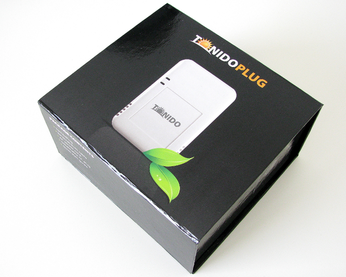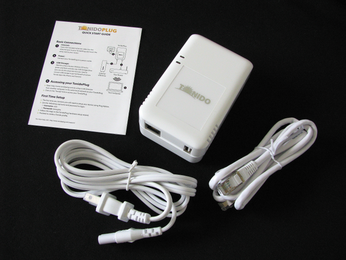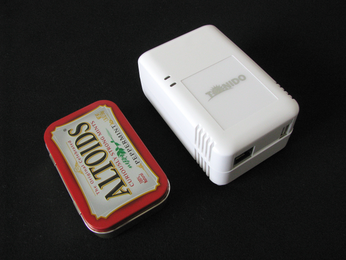First Look at TonidoPlug

Productivity Sauce
For Linux Pro Magazine readers, the name Tonido will sound familiar. I covered this sleek and user-friendly solution that lets you turn an Ubuntu-based machine into a nifty server in issue 105. Recently, CodeLathe, the company behind Tonido, launched TonidoPlug -- a tiny Ubuntu-based server running the Tonido software. In theory, this sounds like a great idea: plug the device, run a quick and simple setup, and you have a fully-functional Linux-based server that you can use to share files and photos, maintain a personal blog and collaborate with other users. But how does this idea work in practice? To find out, CodeLathe kindly agreed to send me a review unit of TonidoPlug, which duly arrived a few days later. While I plan to write a more detailed review of TonidoPlug later, I'd like to share with you my first impressions.
Let's start with the packaging. TonidoPlug's box gives a first indication of how small the device is. Measuring about 6x5.5x3 in, the package looks more like a gift box rather than a server package.
The box contains the TonidoPlug unit, a power cord, an Ethernet cable, and a brief user guide. The device itself is based on the Marvell SheevaPlug plug computer. It's powered by an embedded Marvell Sheeva™ CPU core running at 1.2 GHz backed up by 512MB DDR2 RAM and a 512MB flash disk. The device sports an Ethernet jack for network connectivity and a single USB port for additional storage.
Setting up TonidoPlug is pretty straightforward. Use the supplied Ethernet cable to connect TonidoPlug to your network, plug the device into the mains, and the server is ready to go. Use another machine on the network to go to http://www.tonidoplug.com/ip, and once the server has been located, a configuration wizard will guide you through the configuration process.
By default, TonidoPlug is not accessible from the Web, but you can enable this feature from the Tonido dashboard. Once you've done that, you can access your TonidoPlug server via the http://<tonidoid>.tonidoid.com:<port> address.
The Tonido software installed on TonidoPlug is identical to the standalone package that has been covered in the article, but it does include a few additional applications: WebsharePro (application for sharing files and documents, Torrent (torrent manager), Explorer (file manager) and Plug Admin (administration utility for managing TonidoPlug).
The default 512MB storage can be expanded by plugging a USB stick or a USB hard disk into TonidoPlug. As soon as you do that, TonidoPlug automatically detects the connected storage device, and you can use it right away. No fuss, no muss.
Finally, you can connect to TonidoPlug via ssh. This probably won't matter to most TonidoPlug users, but Linux geeks would appreciate the ability to tweak and hack the device.
So far, I like what I see. The hardware is excellent, setup is a breeze, and the supplied software covers all the bases.
Comments
comments powered by DisqusSubscribe to our Linux Newsletters
Find Linux and Open Source Jobs
Subscribe to our ADMIN Newsletters
Support Our Work
Linux Magazine content is made possible with support from readers like you. Please consider contributing when you’ve found an article to be beneficial.

News
-
Parrot OS Switches to KDE Plasma Desktop
Yet another distro is making the move to the KDE Plasma desktop.
-
TUXEDO Announces Gemini 17
TUXEDO Computers has released the fourth generation of its Gemini laptop with plenty of updates.
-
Two New Distros Adopt Enlightenment
MX Moksha and AV Linux 25 join ranks with Bodhi Linux and embrace the Enlightenment desktop.
-
Solus Linux 4.8 Removes Python 2
Solus Linux 4.8 has been released with the latest Linux kernel, updated desktops, and a key removal.
-
Zorin OS 18 Hits over a Million Downloads
If you doubt Linux isn't gaining popularity, you only have to look at Zorin OS's download numbers.
-
TUXEDO Computers Scraps Snapdragon X1E-Based Laptop
Due to issues with a Snapdragon CPU, TUXEDO Computers has cancelled its plans to release a laptop based on this elite hardware.
-
Debian Unleashes Debian Libre Live
Debian Libre Live keeps your machine free of proprietary software.
-
Valve Announces Pending Release of Steam Machine
Shout it to the heavens: Steam Machine, powered by Linux, is set to arrive in 2026.
-
Happy Birthday, ADMIN Magazine!
ADMIN is celebrating its 15th anniversary with issue #90.
-
Another Linux Malware Discovered
Russian hackers use Hyper-V to hide malware within Linux virtual machines.




Access Without Internet
Is this a commercial version of the SheevaPlug ?
tonidoplug site access only for finding Plug IP initially
If you know how, you can determine the IP address by other means and connect to it.
So you don't need an internet connection everytime to access your plug. Everything is happening inside your own network (unlike other Plug products out there)
local access
Open http://<tonidoplug ip address>:10001/
* http://<tonidoip>:10001/ using browser running in a machine connected to local network. You should see "First Time Setup Wizard". Use userid=root and password=nosoup4u to login.
-wes
not understanding web based administration
So does that mean the system HAS to be accessible from the internet to aministrate is since the administration takes place through the company's web site???
If so what if the user does not have a full time or even an internet connection at all? How do they gain access to the system?